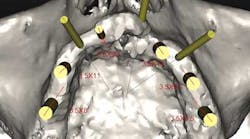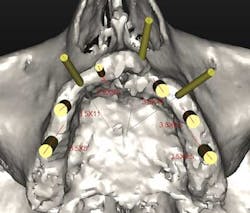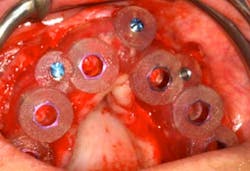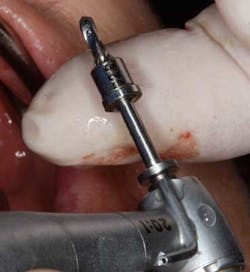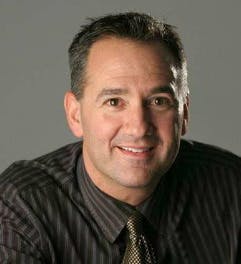Editor’s note: Dr. Sam Simos highlights the DENTSPLY ExpertEase fully guided bone-/tooth-supported surgical guide system. Click here to see the video.
In today’s fast-paced, information-superhighway world, we don’t communicate the same way we did 10 or even five years ago. At our fingertips we have instant access, even on the go, to whatever information we need. In this spirit I am excited to present this fully integrated article, incorporating a technique video of the article case study that you can access through your computer, iPad, or smartphone ... anytime, anywhere.
This case study focuses on fully guided implant surgery. Gone are the days of planning cases by overlaying implant forms on a Panorex. With the introduction of computerized tomography (CT) in 1987 and proprietary third-party implant planning software in 1991, the use of implants has exploded in recent years. By integrating these impressive technologies, dentists today can take planning and executing cases to new heights.
Virtual placement of the actual implant system you are planning to use into the CT scan is a reality. Once completed, you can elect to freehand the placement of the implants or employ a surgical guide, of which there are two types:
- Partially guided, where only the osteotomy sites are prepared using a set of sequential, removable surgical guides and drills.
- Fully guided, whereby one guide is used for both creating osteotomy sites and implant placement. Using a guide ensures precision placement, minimizes surgical complications, increases patient postop comfort, and increases interdisciplinary communication.
This article will highlight DENTSPLY ExpertEase fully guided bone-/tooth-supported surgical guide system.
Case study
A 46-year-old female presents with a 20-year history of wearing a complete set of dentures. She desired a more permanent, stable solution for her upper denture.
After evaluating the Simplant™CT scan (Fig. 1), DENTSPLY ANKYLOSE CT™ implants were selected and ExpertEase™ surgical kit was selected.
Fig. 1: Simplant 3D rendering of fixation screws and implants.
Once the flap is made, the guide is inserted. Fixation screws are used to secure the guide (Fig. 2).
Fig. 2: Bone-supported ExpertEase surgical guide in place with fixation screws.
Osteotomies are prepared using four different osteotomy drills and sleeves (Fig. 3) that fit precisely into the guide. These drills are programmed to go to the exact depth of the planned implant and are corrected for the thickness of the guide, ensuring exact depth and proper angulation.
Fig. 3: ExpertEase twist drill 2.0 GS and sleeve; second of four osteotomy drills.
All implants are inserted through the ExpertEase guide. Once completed, the guide is removed and healing abutments are placed.
Conclusion
With the advancement of integrated technologies such as the CT scan and proprietary third-party software, fully guided surgeries give clinicians the ability to precisely place single/multiple implants predictably, minimizing surgical complications.
Dr. Sam Simos is nationally recognized as a leader in cosmetic and restorative dentistry. He received his Doctorate of Dental Surgery at Chicago's Loyola University. He teaches postgraduate courses to practicing dentists on comprehensive and restorative dentistry through Allstar Smiles' state-of-the-art Learning Center and client facility in Bolingbrook, Ill., and throughout the country. He is one of 50 leading dentists nationwide who, as part of the Dental Team Concepts & Catapult coterie, promote awareness, communication, and education within the dental profession. Dr. Simos is the founder and president of Allstar Smiles and the Allstar Smiles Learning Center and can be contacted at www.allstarsmiles.com.
